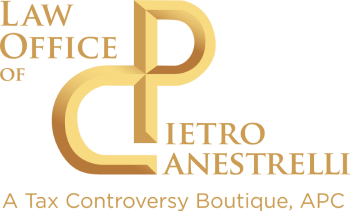Do I Qualify For The Research & Development Tax Credit?
R&D Credit Qualifications
The Research and Development (R&D) Tax Credit is a valuable incentive designed to encourage companies to invest in innovation and development. This R&D tax credit can provide substantial financial benefits, but determining eligibility can often be complex. At The Law Office of Pietro Canestrelli, we specialize in helping businesses navigate the intricacies of the R&D tax credit, ensuring they maximize their potential benefits.
With offices in Temecula and San Diego, and offering online consultations, we are here to assist you wherever you are. In this comprehensive guide, we’ll explore the criteria for qualification, the types of activities that qualify, and the steps you need to take to claim the R&D tax credit.
Understanding the R&D Tax Credit
The Research and Development Tax Credit was established in 1981 as a means to stimulate economic growth through innovation. It offers tax relief to companies that engage in qualifying research activities, potentially reducing their federal and state tax liabilities. This R&D tax credit is available to businesses of all sizes and across various industries, not just those traditionally associated with research and development.
Criteria for Qualification
To qualify for the R&D tax credit, a business must meet specific criteria. The IRS uses a four-part test to determine eligibility for the R&D tax credit:
- Qualified Purpose: The research must aim to create new or improved business components. This includes products, processes, software, techniques, formulas, or inventions intended to improve functionality, performance, reliability, or quality.
- Elimination of Uncertainty: The research activities must seek to eliminate uncertainty regarding the development or improvement of a business component. This means the business must have faced a challenge that required experimentation to resolve.
- Process of Experimentation: The research must involve a process of experimentation to evaluate one or more alternatives to achieve the desired result. This process can include modeling, simulation, or a systematic trial-and-error methodology.
- Technological in Nature: The research must rely on the principles of physical or biological sciences, engineering, or computer science. Activities in the humanities, arts, or social sciences do not qualify for the R&D tax credit.
Types of Qualifying Activities
Various activities can qualify for the R&D tax credit, provided they meet the four-part test. Some common examples include:
– Developing or improving products: This includes creating new products or significantly improving existing ones in terms of functionality, performance, or quality.
– Developing or improving processes: Enhancements to manufacturing processes, production techniques, or operational efficiencies can qualify.
– Software development: Creating or improving software applications, platforms, or systems, especially those intended for internal use or commercial sale.
– Prototyping and testing: Activities related to creating and testing prototypes to evaluate new or improved product designs.
– Technical design and engineering: Involves detailed design work and engineering efforts to develop new products or processes.
– Research related to new materials: Experimentation with new materials or substances to enhance product performance or manufacturing efficiency.
Documentation and Substantiation
Proper documentation is crucial for claiming the R&D tax credit. The IRS requires businesses to maintain detailed records of their research activities to substantiate their claims for the R&D tax credit. Key documentation includes:
– Project descriptions: Detailed descriptions of research projects, outlining objectives, methodologies, and results.
– Time tracking: Records of employee time spent on qualifying research activities, including timesheets or project logs.
– Expense tracking: Documentation of expenses related to research activities, such as wages, supplies, and contract research costs.
– Technical reports and prototypes: Evidence of the experimentation process, including technical reports, prototypes, and test results.

Calculating the R&D Tax Credit
Calculating the R&D tax credit involves determining the eligible expenses and applying the appropriate credit rate. There are two primary methods for calculating the R&D tax credit:
- Regular Credit Method: This method provides a credit equal to 20% of the company’s current-year qualified research expenses (QREs) that exceed a base amount. The base amount is typically a percentage of the company’s average annual gross receipts from the prior four years.
- Alternative Simplified Credit (ASC) Method: The ASC method offers a credit equal to 14% of the QREs that exceed 50% of the average QREs for the prior three years. If the company has no QREs in the previous three years, the R&D tax credit is 6% of the current year’s QREs.
Qualifying Expenses
Several types of expenses can qualify for the R&D tax credit, including:
– Wages: Wages paid to employees directly involved in qualified research activities. This includes researchers, engineers, and supporting staff.
– Supplies: Costs of supplies used in the research process, such as materials for prototypes or lab supplies.
– Contract Research: Payments to third-party contractors for conducting qualifying research activities on behalf of the business.
– Computer Rental: Costs associated with renting or leasing computers used in research activities.
State-Level R&D Tax Credits
In addition to the federal R&D tax credit, many states offer their own R&D tax incentives. These state-level R&D tax credits can further enhance the financial benefits of engaging in research and development. Each state has its own criteria, calculation methods, and application processes, so it’s essential to understand the specific requirements of the states where your business operates.

Steps to Claim the R&D Tax Credit
Claiming the R&D tax credit involves several steps:
- Identify Qualifying Activities and Expenses: Review your company’s activities to identify those that meet the IRS’s four-part test and document all related expenses.
- Select a Calculation Method: Choose between the Regular Credit Method and the ASC Method based on which provides the most substantial benefit.
- Prepare and File Form 6765: Complete IRS Form 6765 (Credit for Increasing Research Activities) and include it with your tax return. This form details your qualifying activities, expenses, and the calculated credit amount.
- Maintain Documentation: Keep thorough documentation of all research activities and expenses to substantiate your R&D tax credit claim in case of an audit.
- Consider State Credits: Investigate and apply for any available state-level R&D tax credits to maximize your benefits.
Common Misconceptions
Several misconceptions can deter businesses from pursuing the R&D tax credit. Some common myths include:
– Only High-Tech Companies Qualify: The R&D tax credit is available to businesses across various industries, not just technology or pharmaceuticals. Manufacturing, agriculture, construction, and other sectors can also qualify.
– Small Businesses Can’t Claim the R&D Tax Credit: The credit is available to businesses of all sizes. In fact, small businesses and startups can significantly benefit from the R&D tax credit.
– It’s Too Complicated to Claim the R&D Tax Credit: While the process can be complex, with proper guidance and documentation, businesses can successfully claim the R&D tax credit. Partnering with experts like The Law Office of Pietro Canestrelli can simplify the process.
– Only Successful Projects Qualify for the R&D Tax Credit: Even if a research project does not yield successful results, the expenses incurred in the process can still qualify for the credit as long as the activities meet the IRS’s criteria.
Contact Us
The R&D tax credit is a powerful incentive designed to encourage innovation and development across various industries. By understanding the qualification criteria, documenting your activities, and accurately calculating your expenses, your business can take full advantage of the R&D tax credit. The Law Office of Pietro Canestrelli is here to help you navigate the complexities of the R&D tax credit, ensuring you maximize your benefits and support your ongoing innovation efforts.
Whether you’re developing new products, improving processes, or exploring new technologies, don’t overlook the potential financial advantages of the R&D tax credit. With offices in Temecula and San Diego, and offering online consultations, The Law Office of Pietro Canestrelli is readily available to assist you. Contact us today to learn more about how we can help you claim this credit and foster your company’s growth and success.
Contact Our Firm
